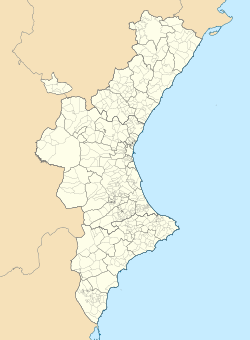
Valencian Union was a regionalist political party in the Valencian Community, Spain.

Alboraya or Alboraia is a town and municipality of the province of Valencia, Spain. It is situated very close to the city of Valencia.

Vinaròs is a city located in eastern Spain and the capital of the Baix Maestrat in the province of Castellón. It is in the border between the Valencian Community and Catalonia. Vinaròs is a fishing harbour and tourist destination.
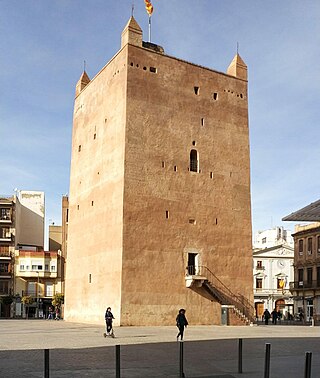
Torrent is a city located within the metropolitan area of the city of Valencia, Spain. It is the largest municipality of the Horta Oest comarca, with 83,962 inhabitants (2020). It is situated some 7 km from Valencia city proper, to which it is connected via the metro. The two metro stations in Torrent are called Torrent and Torrent Avinguda on lines 1, 2 and 7.

Valencia Airport, also known as Manises Airport, is the tenth-busiest Spanish airport in terms of passengers and second in the Valencian Community after Alicante. It is situated 8 km (5.0 mi) west of the city of Valencia, in Manises. The airport has flight connections to about 20 European countries and 8.53 million passengers passed through the airport in 2019.

Horta Oest was a comarca in the province of Valencia, Valencian Community, Spain.

Metrovalencia is an urban rail including rapid transit and trams, serving Valencia and its metropolitan area. The network is a modern amalgamation of former FEVE narrow gauge electric-operated suburban railways. It is a large suburban network that crosses the city of Valencia, with all trains continuing out to the suburbs. It also has destinations on lines that make it more closely resemble commuter trains. The unique system combines light railway, metro and several tram operations north of the Túria riverbed park with line 4. Trains of lines 1, 3, 5 and 9 have automatic train operation (ATO) in 25.3 kilometers of underground system. Tram lines 4, 6, 8 and 10 are operated by modern trams.
Xirivella is a municipality in the Valencian Community, Spain. It borders the city of Valencia, Alaquàs, Picanya and Mislata. The municipality is divided by the V-30 motorway and the river Turia, with the La Luz district on the eastern part of the river. Since June 2012, a bridge across the motorway has connected both parts. Local issues include noise pollution, caused by the nearby Valencia Airport

Aldaia is a municipality in the comarca of Horta Oest, province of Valencia, Valencian Community, Spain.

Manises is a municipality in the comarca of Horta Oest in the Valencian Community, Spain. Located in the province of Valencia, it had 30,693 inhabitants in 2018 (NSI) and is famous for its pottery and being the location of Valencia Airport.

Paterna is a city and a municipality in the province of Valencia in the Valencian Community, Spain. It is located northeast of the comarca of L'Horta de Valencia, 5 kilometres northwest of the inland suburbs of Valencia, and on the left bank of the river Turia. Its population in 2014 was 67,156 inhabitants, being the eleventh city by population in the Valencian Community.

Picanya is a municipality in the comarca of Horta Sud in the Valencian Community, Spain.

Quart de Poblet is a municipality in the comarca of Horta Oest in the Valencian Community, Spain. It has 25,499 inhabitants.

The Corts Valencianes, commonly known as Les Corts, are the main legislative body of the Generalitat Valenciana and therefore of the Valencian Community. The main location of the Corts is in the Palace of the Borgias in Valencia; however it can meet at any location in the Valencian lands. The Corts has its origins in bodies established in the thirteenth century by King James I of Aragon. The modern institution was established in 1982 under the Valencian statute of autonomy of 1982. The current Corts were elected in 2023.
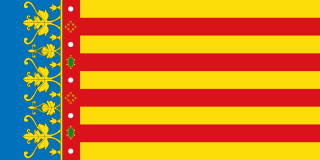
The Valencian Community is an autonomous community of Spain. It is the fourth most populous Spanish autonomous community after Andalusia, Catalonia and the Community of Madrid with more than five million inhabitants. Its homonymous capital Valencia is the third largest city and metropolitan area in Spain. It is located along the Mediterranean coast on the east side of the Iberian Peninsula. It borders Catalonia to the north, Aragon and Castilla–La Mancha to the west, and Murcia to the south, and the Balearic Islands are to its east. The Valencian Community is divided into three provinces: Castellón, Valencia and Alicante.

The 1991 Valencian regional election was held on Sunday, 26 May 1991, to elect the 3rd Corts of the Valencian Community. All 89 seats in the Corts were up for election. The election was held simultaneously with regional elections in twelve other autonomous communities and local elections all throughout Spain.
Valencia city council elections have taken place every four years since 1979 to elect the 33 members of the local government for the city of Valencia, Spain.
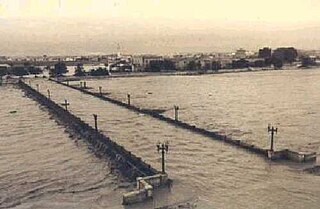
The 1957 Valencia flood was a natural disaster that occurred on 14 October 1957 in Valencia, Spain. The flood resulted in significant damage to property and caused the deaths of at least 81 people. In response to the tragedy, the Spanish government devised and enacted the Plan Sur, which rerouted the city's main river, the Turia.
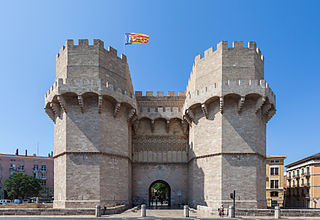
The Serrans Gate or Serranos Gate, also known as Serrans Towers or Serranos Towers is one of the twelve gates that formed part of the ancient city wall, the Christian Wall, of the city of Valencia, Spain. It was built in Valencian Gothic style at the end of the 14th century. Its name is probably due to its location in the northwest of the old city centre, making it the entry point for the royal road connecting Valencia with the comarca or district of Els Serrans as well as the entry point for the royal road to Barcelona, or because the majority of settlers near there in the time of James I of Aragon were from the area around Teruel, whose inhabitants were often called serrans by the Valencians. Alternatively, the gate may also have been named after an important family, the Serrans, who lived in a street with the same name.
Miquel Navarro is a Spanish sculptor, painter and contemporary poet.



